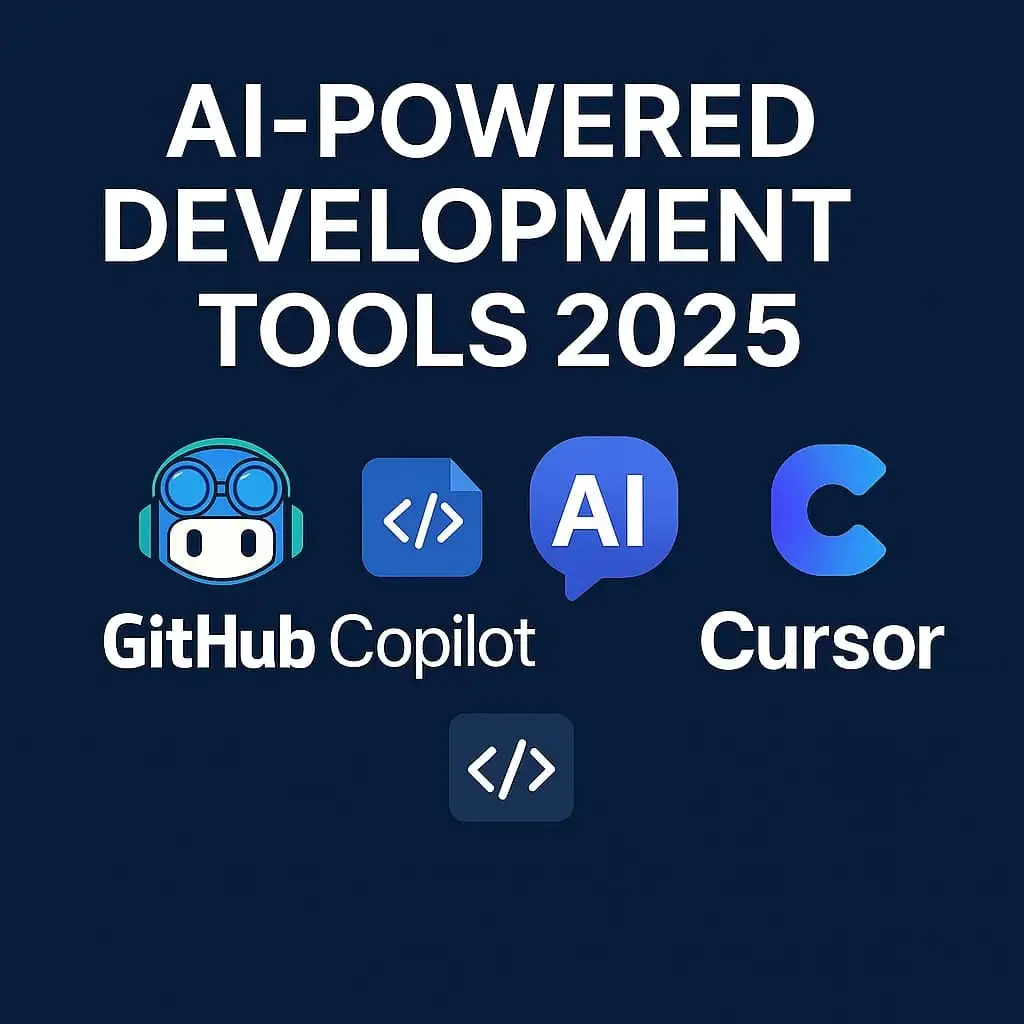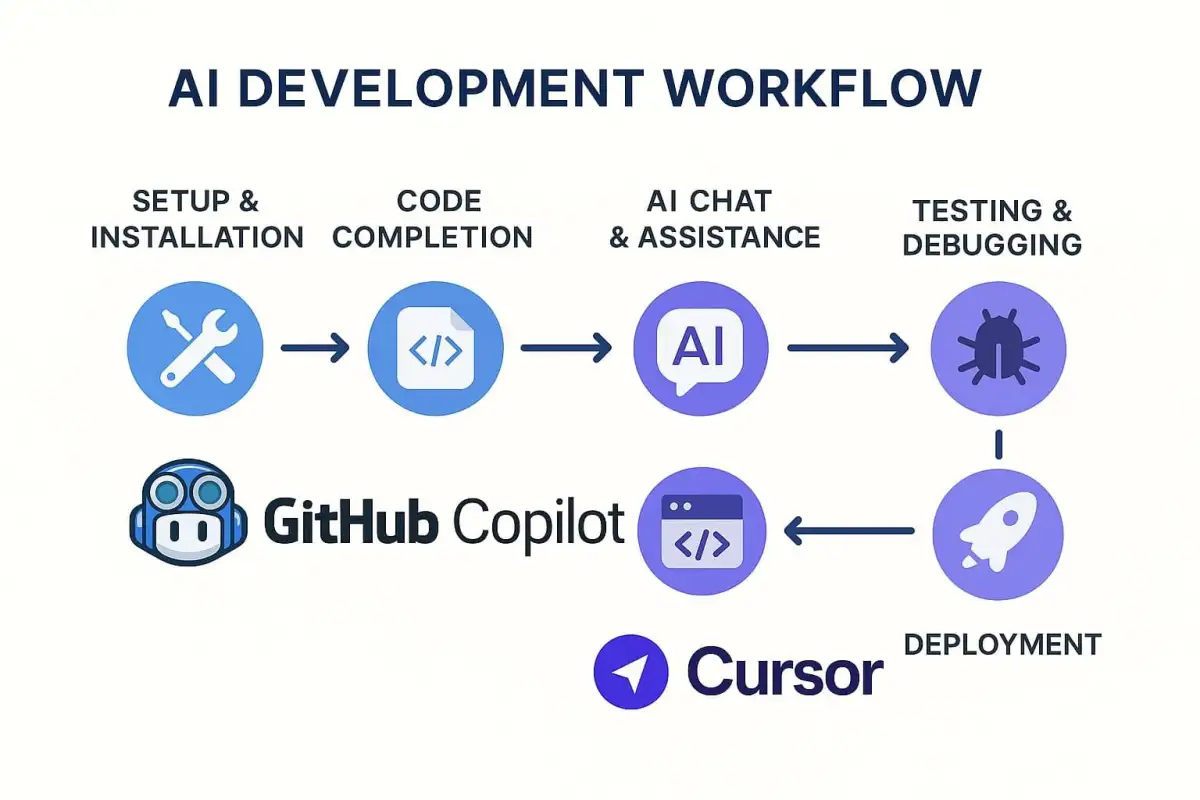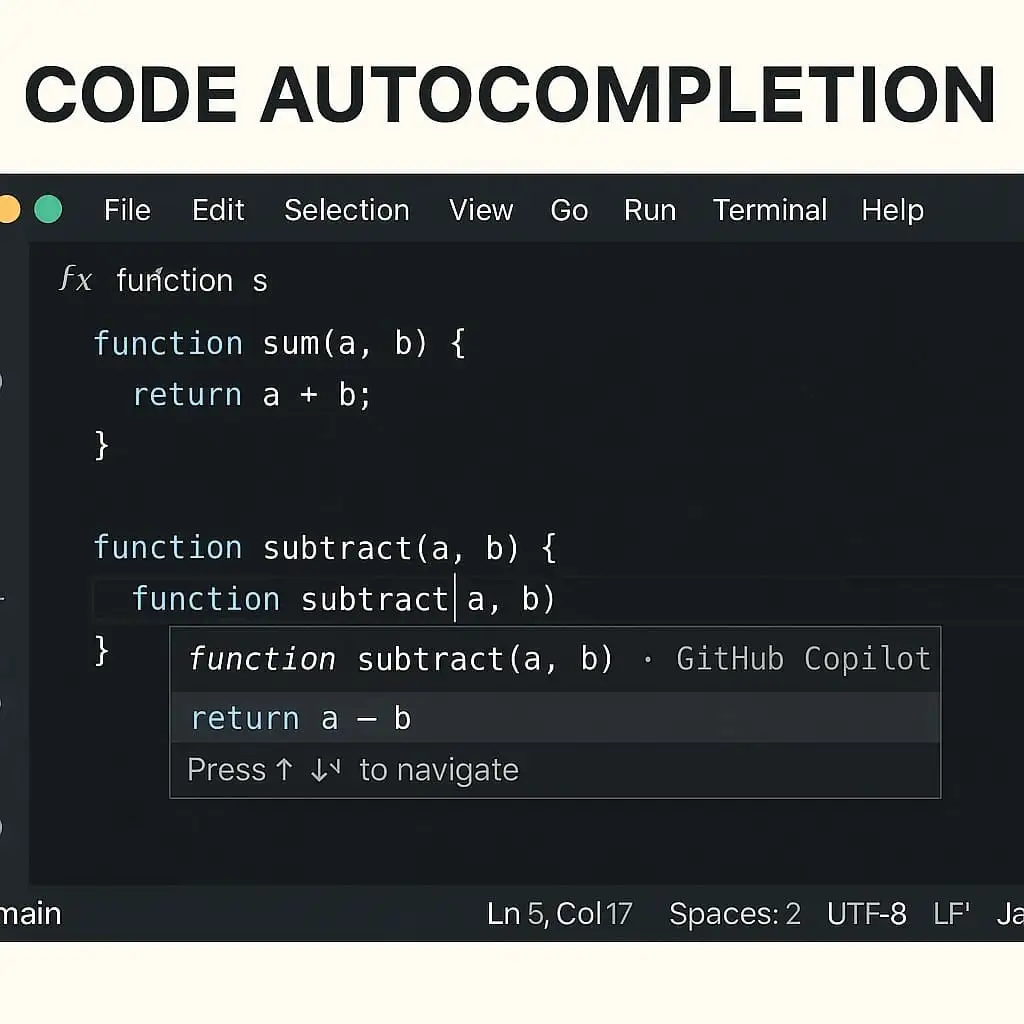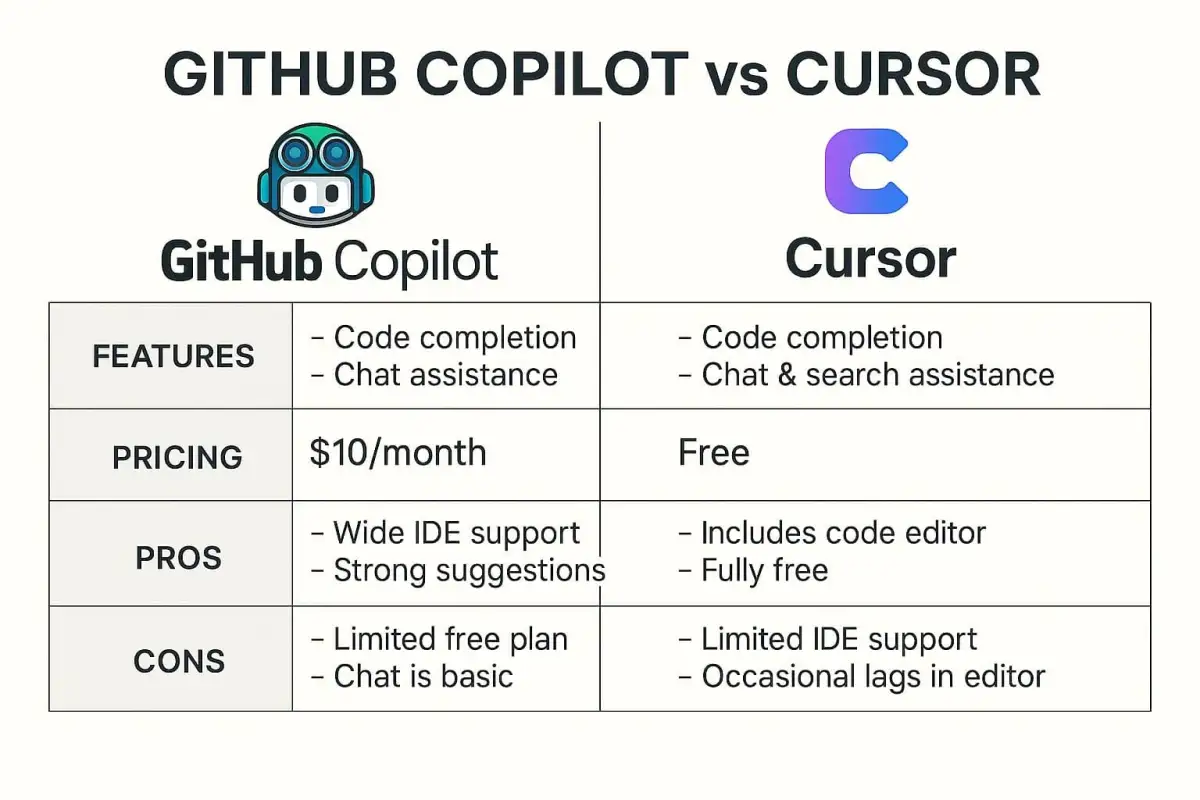AI-powered Development Tools 2025: GitHub Copilot vs Cursor - The Ultimate Guide for Developers
Practical guide for AI-assisted development with GitHub Copilot and Cursor. Setup, best practices, comparison, and productivity tips for developers in 2025.

The AI revolution has fundamentally changed software development. With 76% of developers already using or planning to use AI tools, GitHub Copilot and Cursor have become the most important tools for modern development teams. This comprehensive guide shows you how to optimally use these powerful AI assistants to boost your productivity and write better code.
What are AI-powered Development Tools?
AI-powered Development Tools are intelligent programming assistants that use machine learning and natural language processing to help developers with code creation, optimization, and debugging. They analyze context, understand programming patterns, and generate relevant suggestions in real-time.
The Revolution of AI-assisted Programming
Modern software development is increasingly shaped by AI tools. These technologies automate time-consuming tasks, reduce errors, and enable developers to focus on creative and strategic aspects of programming. From intelligent code completion to automated code reviews – AI tools are transforming every aspect of the development process.
GitHub Copilot: The Established Market Leader

What is GitHub Copilot?
GitHub Copilot is Microsoft’s AI pair programmer, developed in collaboration with OpenAI. As a plugin for various IDEs, Copilot offers intelligent code suggestions based on your project’s context.
New Features 2025
GitHub Copilot Pro+ with GPT-4.5: The latest tier offers exclusive access to the most modern AI models, including GPT-4.5, as well as 1500 premium requests per month.
Copilot Coding Agent (Public Preview): An autonomous AI agent that independently handles GitHub Issues and creates pull requests. You can assign issues to the agent, and it develops solutions that are ready for review.
Copilot Workspace: An integrated development environment for pull request refinement and validation.
Enhanced Chat Functions: Skills support and improved context processing for more precise answers.
GitHub Copilot Setup - Step by Step
Prerequisites
GitHub account with Copilot access
Supported IDE (VS Code, JetBrains, Visual Studio, etc.)
Installation in VS Code
Plugin Installation: Search for “GitHub Copilot” in the VS Code Extension Marketplace
Authentication: Follow the instructions for GitHub login
Activation: Check the Copilot icon in the status bar
Optimize Configuration
// Enable advanced suggestions
"github.copilot.enable": {
"*": true,
"yaml": false,
"plaintext": false
}Best Practices for GitHub Copilot

1. Effective Prompt Creation
Set clear goals: Start with a high-level description of your intention:
/*
Create a Markdown editor in Next.js with the following features:
- Use React Hooks
- State for Markdown with default text
- Live preview during input
- Support for basic Markdown syntax
*/2. Provide Concrete Examples
// Extract names from array of arrays
// Desired result: ['John', 'Jane', 'Bob']
const data = [
[{ name: 'John', age: 25 }, { name: 'Jane', age: 30 }],
[{ name: 'Bob', age: 40 }]
];3. Break Down Complex Tasks
Step 1: Implement basic function
Step 2: Add error handling
Step 3: Write tests
Step 4: Optimization
Cursor: The Innovative Challenger
What is Cursor?
Cursor is an AI-first code editor, based on a VS Code fork, specifically developed for AI-assisted development. With over 15 different AI models and advanced features like Agent Mode, Cursor offers a comprehensive AI development environment.
Cursor’s Core Functions
Advanced Code Completion
Multi-line Edit Suggestions: Cursor can suggest multi-line changes
Next Cursor Position Prediction: Intelligent prediction of the next cursor position
Smart Rewrites: Automatic correction and improvement of code
Integrated Chat Features
Codebase Queries: Search your entire codebase with natural language
Code References: Reference specific code blocks or files
Image Support: Drag-and-drop images for visual context
Web Search Integration: Current information directly in code queries
Cursor Installation and Setup
Windows Installation
Download: Visit cursor.com and download the Windows version
Installation: Double-click the .exe file and follow the installation wizard
First Login: Sign in with your preferred account
Linux/Ubuntu Installation
# Download the AppImage
chmod +x cursor-*.AppImage
# FUSE installation (if needed)
sudo apt-get install libfuse2
# Run Cursor
./cursor-*.AppImageDesktop Integration (Linux)
# Move AppImage to /opt
sudo mv cursor-*.AppImage /opt/cursor.appimage
# Create desktop entry
sudo nano /usr/share/applications/cursor.desktop
[Desktop Entry]
Name=Cursor
Exec=/opt/cursor.appimage
Icon=/opt/cursor.png
Type=Application
Categories=Development;Cursor Productivity Hacks
1. Configure Global AI Rules
- Don't give high-level advice
- Respond with actual code, avoid chatter
- Be casual and treat me as an expert
- Don't mention that you're an AI2. Cmd+K for Inline Code Generation
# Prompt: "Create a function for Fibonacci calculation"
def fibonacci(n):
if n <= 1:
return n
return fibonacci(n-1) + fibonacci(n-2)3. Agent Mode for Multi-File Changes
Agent Mode can make complex changes across multiple files by understanding the entire project context.
GitHub Copilot vs Cursor: The Detailed Comparison

Feature Comparison
| Feature | GitHub Copilot | Cursor |
|---|---|---|
| Base Editor | Plugin for various IDEs | Standalone VS Code Fork |
| Pricing Model | Free/Pro ($10)/Pro+ ($20) | Free/Pro ($20) |
| AI Models | GPT-4, GPT-4.5, Claude, Mistral | 15+ models (Claude 3.5, GPT-4, local) |
| Code Completion | Inline suggestions, Tab completion | Multi-line, Next-edit prediction |
| Chat Interface | Copilot Chat with Skills | Integrated chat with codebase context |
| Multi-File Editing | Limited | Yes, with Agent Mode |
| Codebase Understanding | Good with GitHub integration | Very good through indexing |
| Installation | Plugin required | Standalone download |
| Offline Usage | No | Partially with local models |
| Learning Curve | Medium | Low |
When Should You Choose GitHub Copilot?
GitHub Copilot is ideal for:
Existing IDE workflows (JetBrains, Visual Studio)
Teams with strong GitHub integration
Enterprise environments with specific compliance requirements
Developers who want to gradually introduce AI features
When Should You Choose Cursor?
Cursor is perfect for:
AI-first development approaches
Complex projects with extensive multi-file changes
Experimental development with various AI models
Teams that want maximum AI integration
Practical Use Cases and Workflows
Workflow 1: API Development with GitHub Copilot
// 1. Comment as prompt
// Create a REST API for user management with Express.js
// 2. Copilot generates basic structure
const express = require('express');
const app = express();
// 3. Further details through comments
// GET /users - Retrieve all users
app.get('/users', async (req, res) => {
// Copilot auto-completes
});Workflow 2: React Component with Cursor
// Cursor Agent Mode: "Create a reusable Button component"
// Activate Cmd+K, enter prompt, Accept to take over
import React from 'react';
import PropTypes from 'prop-types';
const Button = ({
variant = 'primary',
size = 'medium',
onClick,
children,
disabled = false
}) => {
// Cursor generates complete implementation
const baseClasses = 'font-medium rounded focus:outline-none';
// ... further implementation
};Performance Optimization Strategies
Copilot Performance Tips
Clear Issue Descriptions: Well-structured GitHub Issues for better Copilot Agent results
Contextual Comments: Use meaningful comments for better suggestions
Iterative Refinement: Use chat for gradual improvements
Cursor Efficiency Hacks
Codebase Indexing: Let Cursor understand your entire codebase
Custom Rules: Define project-specific AI behavior rules
Multi-Model Strategy: Use different models for different tasks
Security and Best Practices
Code Security with AI Tools
Secure Development
Code Review: Always review AI-generated code
Sensitive Data: No API keys or passwords in prompts
Testing: Comprehensive tests for AI-generated code
Enterprise Considerations
Data Policies: Understand how AI tools process your data
Compliance: Consider industry-specific requirements
Team Training: Training for effective AI tool usage
Future Outlook: AI Development 2025 and Beyond
Emerging Trends
Multi-Agent Systems
The future belongs to systems like Copilot Coding Agent that take on autonomous development tasks. These agents will independently develop complex features from planning to implementation.
Local AI Models
Tools like Cursor are pioneering the integration of local AI models for better privacy and offline usage. This development will be particularly important for enterprise environments.
Context-Aware AI
Improved codebase understanding and project-specific adaptations will make AI tools even more precise. Cursor’s codebase indexing already shows where the journey is heading.
Conclusion and Recommendations
For Beginners
Start with GitHub Copilot if you:
Work in existing IDE workflows
Prefer gradual AI integration
Use strong GitHub integration
For Advanced Users
Choose Cursor if you:
Practice AI-first development
Develop complex multi-file projects
Seek maximum AI integration
Hybrid Approach
Many developers use both tools depending on project requirements. GitHub Copilot for daily development in familiar IDEs, Cursor for experimental projects and complex AI-assisted tasks.
Next Steps
Test Both Tools: Use the free tiers for initial experience
Experiment with Prompts: Develop effective prompt strategies
Join Communities: Follow updates and best practices in developer communities
Integrate Workflow: Adapt the tools to your specific development processes
The AI revolution in software development has just begun. With GitHub Copilot and Cursor, you have the tools to be at the forefront of this development and exponentially increase your productivity as a developer.